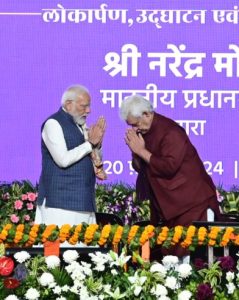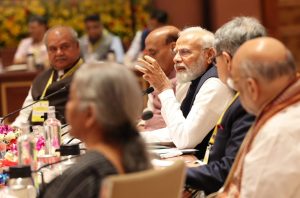Emerging economy faces scourge of dollar

By Nancy Sharma
New Delhi, October 16: Amid the furious run of the dollar to the disadvantage of emerging economies, India has called for a cessation of rate hikes with the Central banks of the developed countries, including the Fed. The Finance Minister Nirmala Sitharaman and the RBI Governor Shaktikanta Das have strongly argued the case of the developing countries against rate hikes, which are jeopardizing the interests of the emerging economies.
“I believe the IMF needs to increase resources available for emerging and low-income countries to safeguard the global financial system. Therefore, concluding the 16th GRQ by December 15th, 2023 is vital for increasing the voting rights of emerging market economies (EMES) in line with their relative positions in the world economy,” said Sitharaman.
Emerging and the Low-income countries have been severely hit by the recent chain of events commencing from the unprecedented pandemic shock to the Ukraine-Russia war, their spill overs, inflationary pressures, and the global economic slowdown. As the world economy recovers, the synthesis has posed exacerbated debt distress in many low-income countries. As a result, total foreign reserves held by emerging markets and developing economies fell by more than six per cent in the first seven months of 2022.
For instance, the Reserve Bank of India had to burn $110 billion (equivalent to less than nine months of imports) to service the hiked global interest rates. Earlier India was dealing with the twin challenges of the pandemic aftermath and the geopolitical tensions between Russia and Ukraine. Now, the table of twin challenges has turned into a multi-folded one, with inflationary pressures, weakening of the dollar and constrained fiscal conditions due to tightened monetary policy dampening the aggregate demand.
During the free fall against the dollar, the currencies of the developed economies have reflected higher devaluation while the Indian Rupee is the only currency in the international scenario which has held back its resilient position which a devaluation of only 10 per cent against 22 per cent of the British pound (£), from 2021 to 2022.
Towards De-dollarization
The Fed’s monetary policy has a long tidal effect on global dollar liquidity as it has cyclically shifted between easing and tightening in response to its own economic problems. When policy is loose, emerging economies may overheat, and austerity can create debt defaults and economic crises in developing countries. At present, the weaponization of the dollar amidst global supply chain disruptions and western sanctions through the abuse of the dollar hegemony is pushing the world economy into recession.
On the other hand, the foreign currency assets (FCA) contribute 93 per cent to the foreign exchange reserves of India as a multi-currency portfolio comprising major currencies. Against this backdrop, the RBI is aiming to de-dollarize global trade and the Indian economy and step up the gold purchase.
“In order to promote the growth of global trade with emphasis on exports from India and to support the increasing interest of the global trading community in INR, it has been decided to put in place an additional arrangement for invoicing, payment, and settlement of exports and imports in INR.” RBI has said recently.
Also, to better serve their economic interest, the BRICS countries are working on establishing a new reserve currency based on a basket of currencies of the five-nation bloc — the Chinese RMB Yuan (¥), the Russian Ruble (₽), the Indian Rupee (₹), the Brazilian Real (R$) and the South African Rand (®). It is noteworthy from the historic data that the US dollar ($) has depreciated against the Russian Ruble (₽) and Brazilian Real (R$) while the Euro (£) has depreciated against all the BRICS currencies.
Also, BRICS has been working on establishing a joint payment network to cut reliance on the Western financial system by increasing the use of local currencies in mutual trade. Despite sanctions and SWIFT disconnection, the Russian Ruble (₽) has been the strongest-performing currency in the world this year, gaining on average over 30 per cent in value. The global slowdown is urging us to reconsider the payment systems worldwide and creating a vacuum for a new mechanism to strengthen cooperation and coordination.
(Author is a researcher with Public Policy Research Centre)








